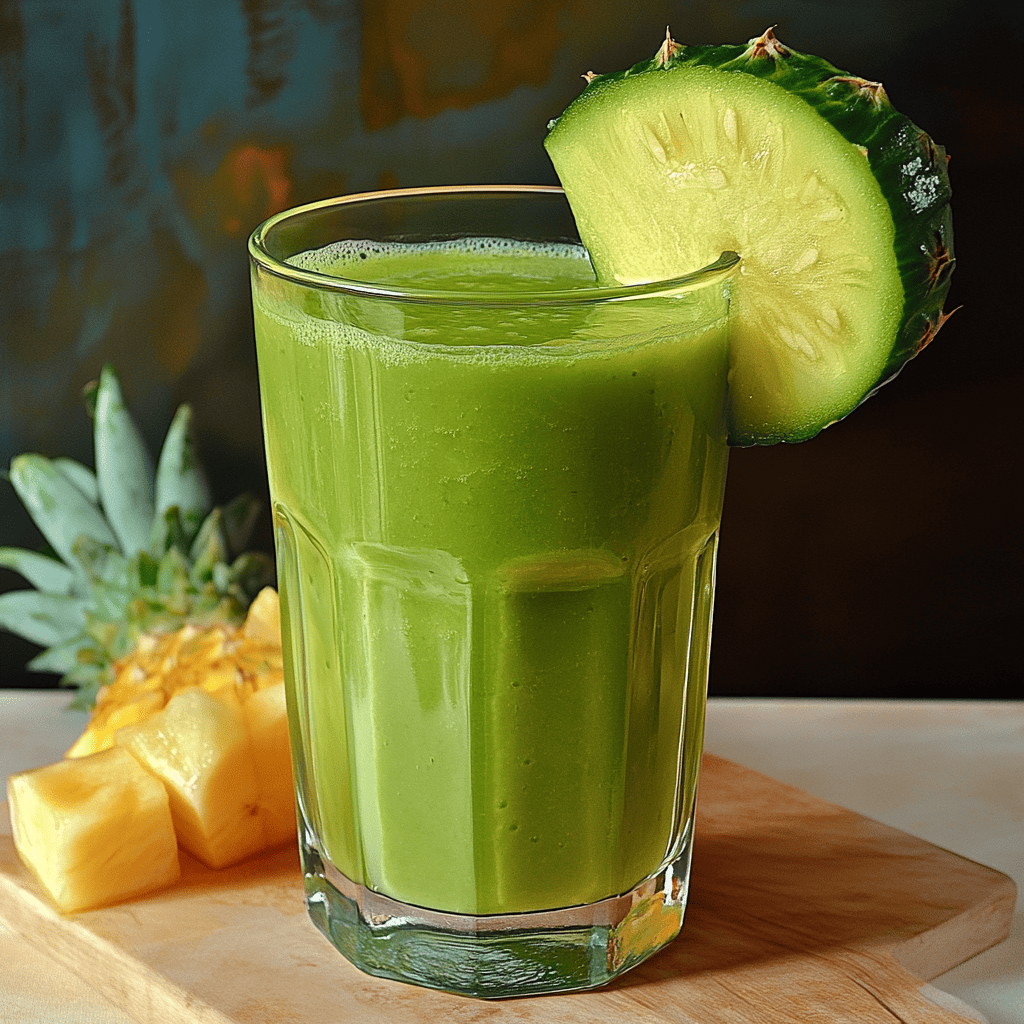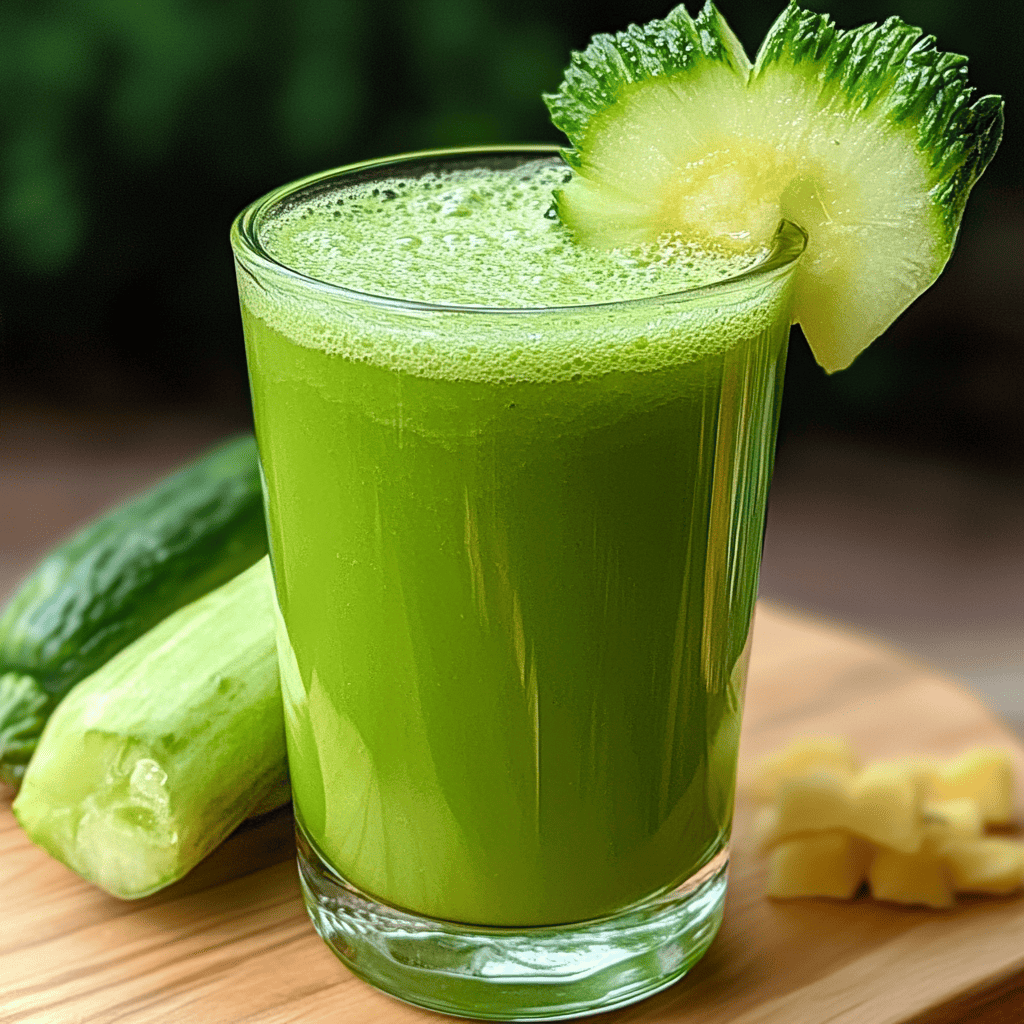Green Detox Juice
Green Detox Juice:
Introduction to Green Juice
Green juice is a natural beverage made from a combination of fresh fruits, vegetables, and herbs. Its popularity has grown in recent years due to its numerous health benefits, making it a key component of healthy diets and detox programs.
Throughout history, different cultures have used natural beverages as home remedies to improve digestion, strengthen the immune system, and detoxify the body. Ingredients such as cucumber, pineapple, parsley, and celery have been recognized for their hydrating, diuretic, and antioxidant properties.
Green juice is an excellent option for those looking to improve their diet naturally. Thanks to its high content of vitamins, minerals, and fiber, this drink helps cleanse the body, improve digestion, and provide energy. Its preparation is also simple and versatile, allowing you to adapt the ingredients to suit each person’s taste and needs.
In this analysis, we’ll explore the history of green juice, its key ingredients, its health benefits, and its impact on modern nutrition. Is it truly a healthy elixir or just a passing fad? Join us on this journey through the fascinating world of green juices.

History of Green Juice
Green juice, like the one pictured, has roots in various cultures that have used natural drinks made from fruits, vegetables, and herbs for their health benefits. Although it’s very popular today in detox and wellness diets, its history dates back to traditional medicine and healthy eating practices across different civilizations.
Origins in Traditional Medicine
In ancient China and India, traditional Chinese medicine and Ayurveda used herbs, fruits, and vegetables in liquid form to detoxify the body and balance vital energy. Ingredients such as cucumber, cilantro, and pineapple were already used for their refreshing and digestive properties.
Meanwhile, in Latin America, indigenous peoples made drinks based on herbs and tropical fruits such as pineapple, tamarind, and guava. These ingredients were believed to aid digestion and strengthen the body.
Evolution and Modern Popularity
The concept of “green juice” began to gain popularity in the 20th century with the rise of natural eating and vegetarianism. During the 1970s and 1980s, holistic health advocates promoted the consumption of fresh juices as a way to cleanse the body of toxins. In recent years, the trend of detox smoothies and healthy living has further boosted its consumption, combining fruits and vegetables in delicious drinks.
Green Juice with Pineapple and Cucumber
This particular juice, which contains pineapple, cucumber, and green herbs like parsley and cilantro, has become a favorite due to its refreshing taste and multiple benefits for digestion, hydration, and detoxification. Today, it’s a common beverage in many parts of the world, especially in healthy diets and wellness plans.
Green juice isn’t just a fad, but a tradition that has evolved over time, adapting to the needs of each generation. Have you ever tried it?
Benefits:
- Natural Detoxifier: Thanks to the pineapple and cucumber, this juice helps eliminate toxins from the body.
- Hydrating and Refreshing: Cucumber has a high water content, ideal for maintaining hydration.
- Aids Digestion: Pineapple contains bromelain, an enzyme that aids digestion and reduces bloating.
- Rich in Vitamins and Minerals: Provides vitamin C, antioxidants and fiber, strengthening the immune system.

Ingredients:
- 1 cup of diced pineapple
- ½ cucumber
- 1 sprig of parsley or cilantro
- 1 glass of water
- Juice of ½ lemon (optional)
- Honey or natural sweetener to taste (optional)
Preparation:
- Wash the ingredients well.
- Peel the pineapple and cut into pieces.
- Cut the cucumber into slices (you can leave the peel on if it is well washed).
- Add all the ingredients to the blender along with the water.
- Blend until smooth.
- Strain if you prefer a thinner texture or drink it straight to retain the fiber.
- Serve in a glass with ice and garnish with a pineapple slice. Enjoy!
Questions about Green Juice
- What are the main health benefits of green juice?
- Are there any contraindications or side effects from consuming it in excess?
- What ingredients can be combined to enhance their purifying effects?
- What is the best time of day to drink green juice and why?
- Is it recommended to take it on an empty stomach or with breakfast?
- Does green juice really help you lose weight or is it a myth?
- Is it better to prepare green juice with a blender or a juicer?
- How long can a green juice be stored without losing its properties?
- Can children and pregnant women consume green juice?
- What is the difference between a green juice and a green smoothie?
Other information about Green Juice
Nutritional Properties:
Green juice is rich in vitamins A, C and K, minerals such as potassium and magnesium, and antioxidants that combat cellular aging.
Benefits for Digestion:
Thanks to the fiber and enzymes present in ingredients like cucumber and pineapple, green juice helps improve digestion and prevent constipation.
Detox Effect:
Its parsley, celery, and lemon content facilitates the elimination of toxins from the body, promoting natural detoxification of the liver and kidneys.
Hydration and Natural Energy:
The high percentage of water in green juice makes it an excellent option to stay hydrated and increase energy levels naturally.
Weight Loss Ally:
Green juice is low in calories and helps reduce fluid retention, making it an ideal complement to weight loss diets.
Tip: For best results, it is recommended to combine green juice consumption with a balanced diet and regular physical activity.
Texture and Flavor
- Texture: Smooth and liquid, although it can be slightly thick if made with raw, unstrained fruits and vegetables. When blended and strained, it becomes lighter and more fluid .
- Flavor: Fresh, slightly sweet, and herbal , with acidic notes if it contains citrus. The flavor varies depending on the ingredients, but usually strikes a balance between green (spinach, celery) and fruity (apple, pineapple, lemon).
- It can have a spicy or fresh touch if ginger or mint is added .
Consumer Context
- Widely consumed in healthy diets, detox cleanses, intermittent fasting , or as part of morning routines.
- Popular for breakfast, after exercise or as a revitalizing snack .
- Common in juice bars, health cafes, gyms and at home .
Visual Aspect
- Vibrant or soft green color , depending on the proportion between vegetables and fruits.
- It can be served with ice, in a clear glass or glass bottle , to highlight its freshness.
- It is sometimes decorated with a slice of lemon, cucumber or a mint leaf .
Curiosities
- Although the concept of “detox” is more popular than scientific, this juice provides antioxidants, fiber, vitamins and natural minerals .
- It can be infinitely customized: there are versions with spirulina, chia, coconut water, cucumber, parsley, nopal, etc.
- It is a favorite among celebrities, athletes and wellness lovers , as part of their daily routines.
- It is also used as a light alternative for those who want to reduce their consumption of coffee or sugary drinks .
Estimated Nutritional Value (per 300 ml glass)
(Varies depending on ingredients, here is a common example with spinach, celery, pineapple, green apple and lemon)
- Calories: 80 – 120 kcal
- Carbohydrates: 18 – 25 g
- Natural sugars: 12 – 20 g
- Fiber: 2 – 4 g (more if not strained)
- Vitamin C: High
- Vitamin A and K: High (from green leafy vegetables)
- Potassium: High
- Proteins and fats: minimal
Other Interesting Information
- It is recommended to drink it immediately to preserve its properties, as it oxidizes quickly.
- It can be combined with natural supplements such as collagen, turmeric or liquid chlorophyll.
- Ideal for hydrating, improving digestion, and providing natural energy to the body without processed foods or added sugars.

Conclusion on Green Juice
Green juice has become an essential beverage in healthy eating habits thanks to its richness in vitamins, minerals, and antioxidants. Its popularity is due to the multiple benefits it provides to the body, such as detoxification, improved digestion, strengthening the immune system, and contributing to natural weight loss.
Furthermore, its preparation is simple and allows for a wide variety of ingredient combinations, making it adaptable to different tastes and needs. However, it is important to remember that green juice should not replace main meals or be considered a miracle cure. For best results, it should be part of a balanced lifestyle, complemented by a nutritious diet and regular physical activity.
In conclusion, green juice is an excellent ally for well-being, as long as it’s consumed responsibly and combined with other healthy habits. Its versatility and benefits make it a refreshing and revitalizing option for everyday life. Including it in your diet can be a great step toward a healthier, more energetic life!

